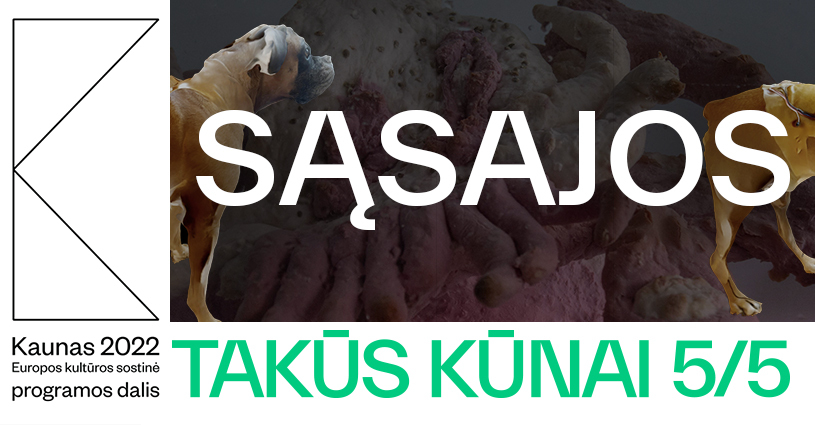
Fluid bodies 5/5. Interfaces
The exhibition is open from 23 September 6 pm. Entrance is free during the opening evening.
Open: 23 September - 23 October
Saturday - Sunday 12 pm - 8 pm
Three works by Lithuanian artists complete the Fluid Bodies series with authentic interpretations of the theme of ecology. This time, the exhibition will talk about the possibilities of symbiosis between the human and the non-human in the viscous context of microbes, man and dog or geological time. Mindaugas Gapševičius, Kamilė Krasauskaitė and Miglė Vyčinaitė each came up with a keyword for the exhibition’s title.
Mindaugas Gapševičius offered a keyword interfaces. His artwork Interfaces for Boris and Mindaugas created in collaboration with Boris (model), Brigita Kasperaitė and Mantas Talmantas (3D scans), Mindaugas Miselis (electronics).
According to the artist, sometimes humans design headgear or coats for their pets to make them look like humans. Sometimes humans attach prosthetic limbs to their disabled pets to help them experience their umwelt. Sometimes humans try to understand their pets by looking into their eyes or watching their movements. Interfaces for Boris and Mindaugas provides interfaces for the boxer dog Boris and his host, so that the host experiences how the dog behaves, and the dog experiences the behaviour of his host. Communication is triggered by the electrical signal. Heart rate and brain activity are measured, interpreted, and converted into electrical signals so they are exchanged between the two via the Internet. The participatory event invites audiences to try out the interfaces themselves.
Kamilė Krasauskaitė suggested the keyword inclusions. She explains the context of her work: conceptually, metagenomics implies that the human body is a communal gene pool, and its “self-extending symbioses,” are “highly adaptive and robust against environmental perturbation” and “dynamic, self-sustaining processes.” Metaphorical framings built from these understandings of microbial communities bring system based understanding of complex processes to the international realm.
Kamilė says, that we can’t eliminate our history. The history of ourselves, the history of our parents, our land, region, Earth itself, dreams. It will come back in one way or the other, like an archetypal dream comes to us one night without asking.
Immune memory was first described in 430 BC by the Greek historian Thucydides who noted that “the same man was never attacked twice”. Two thousand years later, we have learned that almost all organisms have innate and acquired immune systems and that microbial pathogens cause diseases.
“Now, it is well established that immune memory is an integral part of adaptive immunity to ensure long-lasting protection against previously encountered pathogens. <…> increasing evidence indicates that innate immune cells can also ‘remember’ certain previously encountered immune stimuli.”
The installation invites to look back into some (metaphorically) diseases and abnormalities. As we were talking about constant changes and cycles, haven’t we forgot to take some lessons from the (y)east?
Miglė Vyčinaitė’s Inclusion is a film about a speculative space where different states of time, myths, post-humanist ideas and a melancholic feeling of a lost future intertwine. The story unfolds in an abandoned landscape where the past intervenes into the future, disrupting the flow of geological time. The story is told by an unknown being who travels around a dystopian territory and discovers the remains of settlements. The atmosphere and visual texture are created by depicting abandoned objects and architectural decay, as well as mystical natural processes.
When examining the reasons for the emptying of the area, the physical emptiness coincides with the narrator’s inner void. Eventually, the protagonist gets stuck in the sticky resin and becomes an amber inclusion. The depiction of post-industrial landscapes and environments used here hints at the absence of human activity. The resurgent nature exists not only as a background to the story but rather as an active participant in it, as a totality of signs, marking invisible bonds that need to be deciphered.
